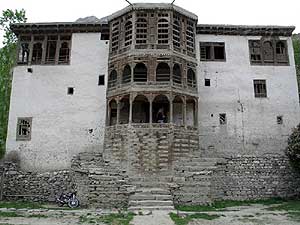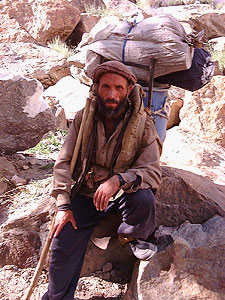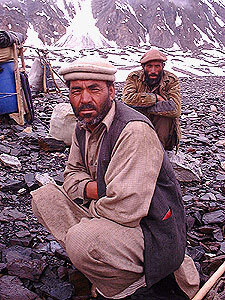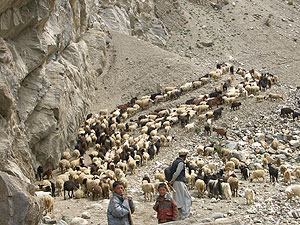Baltis
 Deep in the Karakorum mountains consisting of the arid river valleys of Skardu, Khapulo, Shigar, Rondu and Kharmang lies Baltistan or Baltiyul the historic junction of the Buddhist and Islamic world. This is a region of lovely oases amongst harsh rock walls and ice with some of the highest peaks in the world , four of them exceeding 8000m with K2 the second highest at 8611m. Baltiyul also has Deosai the highest plateau in the world with an average elevation of 3500m .Deosai biodiversity with its millions of flowers blooming over the lush grassland has earned it recognition as a national wilderness park.. The mighty Indus river flows through the middle of this system dividing the high peaks and the deosai plains.
Deep in the Karakorum mountains consisting of the arid river valleys of Skardu, Khapulo, Shigar, Rondu and Kharmang lies Baltistan or Baltiyul the historic junction of the Buddhist and Islamic world. This is a region of lovely oases amongst harsh rock walls and ice with some of the highest peaks in the world , four of them exceeding 8000m with K2 the second highest at 8611m. Baltiyul also has Deosai the highest plateau in the world with an average elevation of 3500m .Deosai biodiversity with its millions of flowers blooming over the lush grassland has earned it recognition as a national wilderness park.. The mighty Indus river flows through the middle of this system dividing the high peaks and the deosai plains.
European historians suggest that Bolor ( Gilgit and Baltistan) was once a centre of Bon shamanism, the indigenous religion of the High Himalaya and the original inhabitants of western Tibet, Ladakh and Baltistan were these very Aryans.
 |
 |
Though at one time this area had been under Tibetan, and later Ladakhi rule, the five main valleys of Baltistan ( Skardu, Shigar, Rondu, Khaplu and Kharmang) were more often principalities left to their own rule . The spread of Islam in the area can be traced to Rinchen (or Rinchana Bhoti), a Tibetan prince who ruled Kashmir from 1319-1323. Inspired by a Muslim sage, Bulbul Shah, Rinchen converted to Islam and changed his name to Sadruddin. By the late 1300s, Sufi preachers had begun to arrive from Persia, ushering in the Islamic era in Kashmir and Baltistan Amongst the rulers of these principalities Ali Sher Khan Anchan (1590-1625) of the Maqpon dynasty kings unified Baltistan and briefly expanded its frontiers up to Ladakh and western Tibet in the east, and in the west till almost the borders of Ghizar and Chitral where Muhtaram Shah 1 of the Kator dynasty ruled from 1590 to 1630.
 When the British left India, they handed control of Gilgit over to the Hindu Maharaja of Kashmir two weeks before the partitioning of the Subcontinent. The Muslim majority of Gilgit favoured joining Pakistan, and when it became known that the Maharaja of Kashmir had declared accession to India, Gilgit saw an insurrection on 1 November 1947. The Dogra governor was imprisoned, and the Gilgit Scouts and Chitral Scouts under Col Mata ul Mulk took over the garrison of Skardu . A provisional local government was established in Gilgit under the presidency of Raja Shah Rais Khan, a member of a former local ruling dynasty.
When the British left India, they handed control of Gilgit over to the Hindu Maharaja of Kashmir two weeks before the partitioning of the Subcontinent. The Muslim majority of Gilgit favoured joining Pakistan, and when it became known that the Maharaja of Kashmir had declared accession to India, Gilgit saw an insurrection on 1 November 1947. The Dogra governor was imprisoned, and the Gilgit Scouts and Chitral Scouts under Col Mata ul Mulk took over the garrison of Skardu . A provisional local government was established in Gilgit under the presidency of Raja Shah Rais Khan, a member of a former local ruling dynasty.
The inhabitants of Baltiyul living in the valleys of the Indus, the Shyok, and their tributaries, have cultural affinities that stretch from Lhasa to Tehran. The Baltis proudly still claim their pre-Islamic culture that has so much in common with Tibet and Ladakh that earned them the nickname of “Little Tibet “. Unlike the rulers of Hunza and Chitral who patronized music , dance and cultural activities unfortunately the principalities of Baltistan did not promote this aspect of their culture. The present day Balti is proud of his cultural heritage and in the lovely valleys of Skardu, Shigar, Rondu, Khaplu and Kharmang a revival of their traditional art and music is taking place.